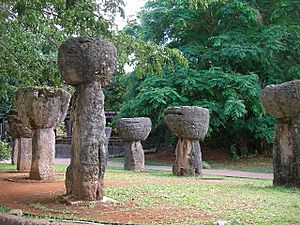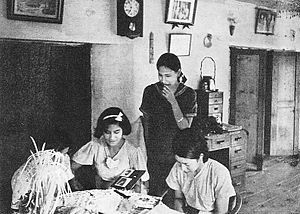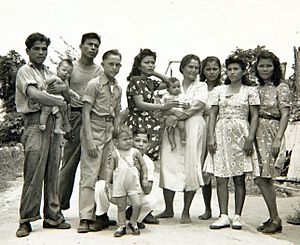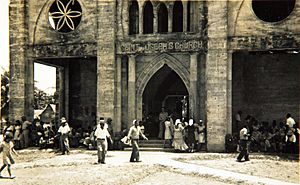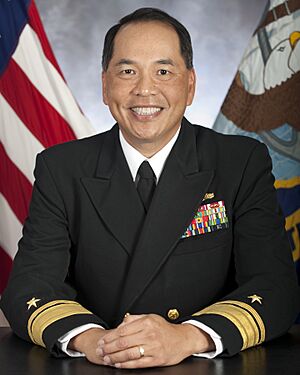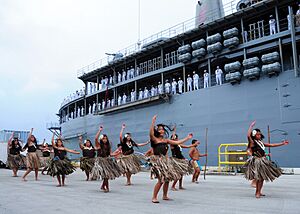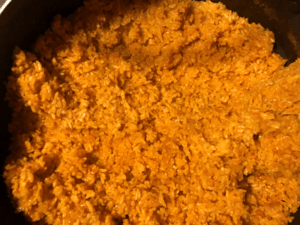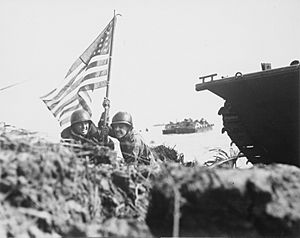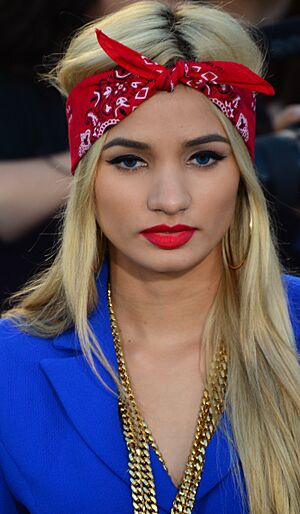Chamorro people facts for kids
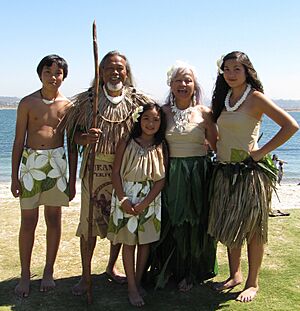
Chamorro performers at the Pacific Islander Festival Association in San Diego, 2010
|
|
| Total population | |
|---|---|
| 147,798 (2010 census) | |
| Regions with significant populations | |
| 63,035 (2020 census) | |
| 12,902 (2010 census) | |
| Languages | |
| Chamorro (native) English (auxiliary) |
|
| Religion | |
| Predominantly Roman Catholic | |
| Related ethnic groups | |
| Other Micronesians | |
The Chamorro people (also called Chamoru) are the original people of the Mariana Islands. These islands are split politically. One part is Guam, a territory of the United States. The other part is the Northern Mariana Islands, which is a commonwealth of the US. Both are in a region called Micronesia.
Many Chamorro people also live in different US states today. These include Hawaii, California, Washington, Texas, Tennessee, Oregon, and Nevada. The US census counts them as Pacific Islander Americans. In 2000, about 64,590 people of Chamorro background lived in Guam. Another 19,000 lived in the Northern Marianas.
Contents
What does the name Chamorro mean?
Before Europeans arrived, Chamorro society had a special system. The highest group was called Chamori.
After Spain took over the Marianas, this system changed. All the native people of the islands eventually became known as "Chamorro." This was a Spanish word used to describe people from outside. The name Chamoru is how the people themselves say it in their own language. It comes from the Spanish word.
Some people think the Spanish word "Chamorro" was used because of how the islanders looked. In Spanish, "Chamorro" can mean "bald" or "close-cropped." Around 1670, a missionary said that men shaved their heads. They left only a small amount of hair on top. But earlier reports from the 1520s said both men and women had long black hair. Later, around 1570, people tied their hair in topknots.
Today, groups on Guam want to use the spelling Chamoru. A law in Guam in 2017 supported this. In 2018, a special group for the Chamoru language said Chamoru is the best way to spell the language and the people's name.
Chamorro Language
The Chamorro language belongs to the Austronesian family. It is part of the Malayo-Polynesian group. Spain ruled Guam for over 300 years. Because of this, the Chamorro language has many words borrowed from Spanish. For example, the traditional Chamorro number system was replaced by Spanish numbers.
Chamorro is still spoken in many homes, but it is becoming less common. However, people are now very interested in bringing the language back. All public schools in Guam and the Northern Marianas must teach Chamorro. This is part of the lessons from elementary to high school.
A common phrase in Chamorro is håfa adai. This greeting is like saying "hello" in English.
History of the Chamorro People
Early Chamorro Life
People believe the Chamorros came to the Marianas Islands from the Philippines. This happened around 1,500 BC. They are closely related to other people who speak Austronesian languages. These include natives from the Philippines, eastern Indonesia, Taiwanese aborigines, and people from the Caroline Islands.
New DNA tests on ancient Chamorro remains show their ancestors came from eastern Indonesia. This was likely from Sulawesi. They were skilled sailors and craftspeople. They knew how to weave and make detailed pottery. The latte stone is a large stone pillar with a round capstone. Early Chamorros used these as foundations for buildings. Today, it is a national symbol.
Chamorro society was based on family lines through the mother. This means the mother's brother often played a more important fatherly role than the child's biological father.
Farming and Food
Spanish records show that Chamorro farmers planted seeds based on the moon's phases. For example, farmers on Guam often planted root crops like sweet potato and yams. They did this during a full moon when the tide was low.
The University of Guam says that farming on Guam was very common in 1940. It was also high in 1975, but it has gone down since then. This includes growing crops, raising animals, and fishing.
Ancient Chamorro Culture
Stories of Creation and Beliefs
An old Chamorro story says the world was made by a brother and sister, Puntan and Fu'uña. When Puntan was dying, he told Fu'uña to use his body to create the universe. She used his eyes to make the Sun and Moon. His eyebrows became rainbows. Most of his other parts became different parts of the Earth.
After she finished, she went to an island called "Guåhan." She turned herself into a giant rock. This rock split open, and all humans came out of it. Some believe this rock was near a church in Agat. Others think it is Laso de Fua in Fouha Bay in Umatac.
Ancient Chamorros honored their ancestors. But they did not have a formal "religion" where they worshipped gods. One account from 1623 said they might have offered human sacrifices. This was to please a "great fish." This might be linked to a Chamorro story about why Guam is narrow in the middle. The story says a giant fish was eating the island. The men could not catch it. So, the women wove a net from their hair. It grew bigger as they sang. The singing charmed the fish and led it into the net.
In April 1672, a Chamorro man and his friend killed a Catholic priest, Father Diego Luis de San Vitores. They were angry because the priest had baptized his child.
Social Groups
Chamorro society was divided into two main groups for over a century after the Spanish arrived. Historical records say there were differences between the Manachang group and the higher Chamorri group. The Manachang were described as shorter and darker-skinned. The Chamorri group had two parts: the upper-middle class Achoti and the highest, ruling Matua class.
An Achoti could become Matua, and a Matua could lose status. But Manachang people were born into that group and could not change their position. The Manachang and Chamorri were not allowed to mix. All groups did physical work, but they had different jobs. Some think Chamorro society was made of people from different backgrounds. This idea might be supported by the Chamorro language and customs.
Clothing and Appearance
Before the Spanish came, Chamorro boys and men did not wear clothes. Girls went without clothes until they were about eight to ten years old. Then they started wearing a small covering. This was made of bark, leaves, turtle shell, or woven mats. Both men and women sometimes wore hats made of woven leaves to protect themselves from the sun.
A writer named Father Pierre Coomans wrote about Chamorro women blackening their teeth. This was a common custom in many parts of Asia. They thought it was beautiful and made them different from animals.
Folklore and Spirits
The Chamorro creation story is about two siblings, Puntan and Fu'una. They created the world using their body parts and souls. Puntan's body parts became the land, sky, rainbows, sun, and moon. Fu'una gave life to the sun, soil, and waters. Then she turned into stone and gave birth to the Chamorro people. Some village names on Guam are linked to body parts from this story. For example, Barrigada means "flank," Tiyan means "stomach," and Hagatna means "blood."
Taotaomo'na are spirits of ancient Chamorros. Birak is a wider term that can mean spirits, demons, or nature spirits. Taotaomo'na means "people of early times." These are supernatural ancestral spirits that Chamorros believe in. They are said to be very strong. They can cause sickness or death to those who upset them. Taotaomo'na can appear as male or female. They can look attractive or monstrous.
Spanish Rule and Changes
On March 6, 1521, Ferdinand Magellan and his crew reached the Marianas. They were the first Europeans to meet the native people. Later Spanish visitors called the people "Chamurres," which came from the local term for the upper class. This became "Chamorros," an old Spanish word for "bald." This might have been because of local hairstyles.
Over many years, the Mariana Islands were ruled by different countries. These included Spain, Germany, Japan, and the United States. Today, Chamorro society is very mixed with different cultures. The people of Rota are the least mixed. Chamorros are mainly of Austronesian background. But they started mixing with Spanish and Filipinos during Spanish rule (1521–1898 AD). Since the late 1800s, many Chamorros have married people from other Pacific Islands, mainland America, the Philippines, China, and Japan.
During the Spanish era, the Spanish tried to convert the natives to Catholicism. People caught practicing old beliefs were punished in public. Chamorros were also given Spanish surnames.
During the Spanish–American War, the United States took over Guam on June 21, 1898. Under a treaty signed in December 1898, Spain gave Guam to the United States. Guam is still listed by the United Nations as a territory that does not govern itself.
World War II and After
Before World War II, the US had five areas in the Pacific Ocean. These included Guam and Wake Island. On December 8, 1941, Japanese forces invaded Guam. This happened hours after the attack on Pearl Harbor. Chamorros from the Northern Marianas, who had been under Japanese rule, were brought to Guam. They helped the Japanese government.
The Japanese treated Chamorros harshly during the two-and-a-half-year occupation. This created a split between Chamorros from Guam and the Northern Marianas. It was a main reason why Guam Chamorros rejected joining the Northern Marianas in the 1960s. During the war, Chamorros faced forced labor, imprisonment, and execution. American forces took back the island on July 21, 1944. This day is now celebrated as Liberation Day.
After World War II, the Guam Organic Act of 1950 made Guam an organized territory of the US. It set up the island's civilian government. It also gave the people US citizenship. Guam's governor was chosen by the US government until 1968. Then, a law allowed the people to elect their governor. Since Guam is not a US state, its citizens cannot vote for president. Their representative in Congress cannot vote either. But they can vote for party delegates in presidential elections.
More and more Chamorros, especially young people, are moving to the US mainland. This makes it harder to define and keep Chamorro identity. On Guam, a Chamorro rights movement has grown. Its leaders want to return ancestral lands to the Chamorro people. They also want to achieve self-determination, meaning they want to decide their own future.
Modern Chamorro Culture
Chamorro culture has been influenced by many other cultures. These include Spanish, Mexican, American, Japanese, and Filipino cultures. Other Pacific Islander groups have also had an impact. German influence in the Northern Marianas can be seen in some names.
The old idea of inafa'maolek is a main value in traditional Chamorro culture. It means "doing good for each other" or "interdependence." Respect for family, community, and elders (man åmko') are important parts of this. However, this can differ among people and families.
American customs and values now strongly influence the culture. This is because the Marianas are US territories. Also, most Chamorro people now live outside the Marianas in the United States. The American military has a big cultural influence. More people join the military from the Marianas than from any other place in the US. On Guam, about 14 people out of 10,000 join. In contrast, Montana, a US state, has about eight people out of 10,000 joining.
Cockfighting and gambling related to it were brought by the Spanish. They have been a popular pastime in Chamorro culture, especially for men. It is still popular with older generations and Filipino immigrants. They raise roosters for cockfighting. However, mixed martial arts fighting has become more popular to watch. This is especially true among younger people. Big events are held throughout the year on Guam and Saipan. They feature local fighters and guests from other places.
Chamorro life has long centered on the mother's family line, or matriarchal clan. The idea of a "clan" coming from a common female ancestor is still followed. Large extended families are still very important in the Marianas.
Sadly, Diabetes and heart disease have become more common among native people. This also affects other Oceanic people living in the Marianas.
Traditional healers called suruhånu (or suruhåna for women) are still highly respected. They know a lot about herbal medicines and spirits.
Religion and Beliefs
Most Chamorros are Roman Catholic. A few people in the Marianas still keep some old customs and beliefs. These are from before the first European arrivals. Some residents will still ask permission from ancestral spirits before going into parts of the jungles.
The Mariana Islands have a very high rate of people who say they belong to a religion. Only a small percentage of the population does not claim a religion.
Chamorro Dance
Chamorro dance is important for cultural practices. It includes chanting, dancing, and storytelling. Across the United States, there are Guma groups. These are led by Chamorro dance teachers. They have been part of historical Guam dance groups. A Guma is a place where Chamorro people teach others about their vibrant culture. It focuses on the land of Guam and the Northern Mariana Islands.
Traditional Chamorro dance costumes were woven and made by hand. Women wore traditional mestizas dresses. Men wore a sadí made from cotton or linen. Both costumes represent the people from Guam. They show the Spanish colonial time and the strength of the people.
A key dance move is shaped like a canoe. The Chamorro people practiced canoe movements with their hands or with traditional wooden sticks. In ancient times, outrigger canoes were used for war, fishing, and sailing.
Chamorro Food
Chamorro food has influences from many cultures. For example, popular foods from other places include different kinds of sweet or savory empanada. These were first brought by Spain. Pancit, a noodle dish, comes from the Philippines. Spanish settlers in the 1600s also brought cattle. This led to dishes like tinala' katne.
Old findings from the Marianas show that rice was grown there long ago. Red rice, made with achoti, is a special food. It clearly shows Chamorro cooking among other Pacific Island foods. It is often served at special events. These include parties (gupot or "fiestas"), nobenas, and graduations. The sauce fina'denne' is served with most meals. Fruits like lemmai, mangga, niyok, and bilimbines are used in many local recipes. In the Marianas, you can also find Korean, Chinese, Japanese, and American food. Local cookies are called guyuria.
Some unique local foods include kelaguen. This is a dish where meat is "cooked" by acid from citrus fruit, not by heat. Tinaktak is a meat dish made with coconut milk. Kå'du fanihi is flying fox or fruit bat soup. Fruit bats and local birds are now rare. This is mainly because the brown tree snake was brought to the islands during World War II. It greatly reduced bird numbers and threatens the fanihi (fruit bat) population. Illegal hunting of fruit bats also threatens them.
Spam and other canned meats were introduced after World War II. This changed what people ate.
Chamorro People in the United States
In 2010, about 148,220 Chamorros lived in the United States. Most were from Guam, but some were from the Northern Marianas and Saipan.
The first Chamorros to move to the US were Guamanians in the early 1900s. Later, small groups moved to Hawaii and the Western US. They worked as farmers. Guam's people became American citizens in 1929. In the 1930s, young Chamorro men joined the US Navy. This led to the first wave of Chamorro military families leaving Guam after World War II in the 1940s.
In 1950, the people of Guam became full American citizens. This made it easier for Guamanians to move to the US. The first big migration happened in the 1950s, with over 160 Guamanians moving to the US. Many went to California. In 1952, Guamanian immigrants started their first group in the US. It was called the Guam Territorial Society. It was in Washington, D.C., where many worked for the Department of Defense.
In the 1960s, hundreds more Guamanians moved to the United States. This was the largest number to move to the country. Most were leaving the Korean War and Typhoon Karen.
In the 1970s, another group of Guamanians arrived in the US. In 1986, the US gained the Northern Marianas Islands. This also helped people from those islands move to the US.
As of 2020, Pierce County, Washington, has the largest Chamorro population. There are 4,931 Chamorro people there. This is about 0.62% of the total population.
Notable Chamorros
- Pia Mia Perez (born 1996), singer-songwriter
- Angel Santos (born 1959), Chamorro Rights Advocate & former Guam Senator
- Craig Santos Perez (born 1980) award-winning poet and essayist
- Theresa H. Arriola, a cultural anthropologist
- Zach Banner (born 1993), American NFL football player
- Ignacia Bordallo Butler (died 1993), businesswoman
- Manny Crisostomo (born 1958), Pulitzer Prize winner
- Joe Duarte (born 1983), mixed martial artist
- Peter Gumataotao, first Chamorro two-star flag officer in the United States military
- Siobhon McManus, teacher & activist
- Walt Nauta, aide to former US president Donald Trump
- Susan Pangelinan, Chamorro-American member of the United States Air Force
- Frank Camacho, martial artist
- Maria Anderson Roberto (born 1880), chaperone for the Navy's Native Nurses program
- Gregorio Sablan (born 1955), Delegate to the U.S. House from the Northern Mariana Islands's at-large congressional district
- Jon Tuck, martial artist
- Francisco B. Rabon (1954), Master of Chamorro Dance
- Ben Blaz (born 1928), 4 Star General Marine Corp
- Benjamin Aguon Leon Guerrero First Classified Col. Guam Police Department
See also
 In Spanish: Pueblo chamorro para niños
In Spanish: Pueblo chamorro para niños
- History of Guam
- History of Oceania
- History of the Pacific Islands
- Guamanian citizenship and nationality
- Native Hawaiians



